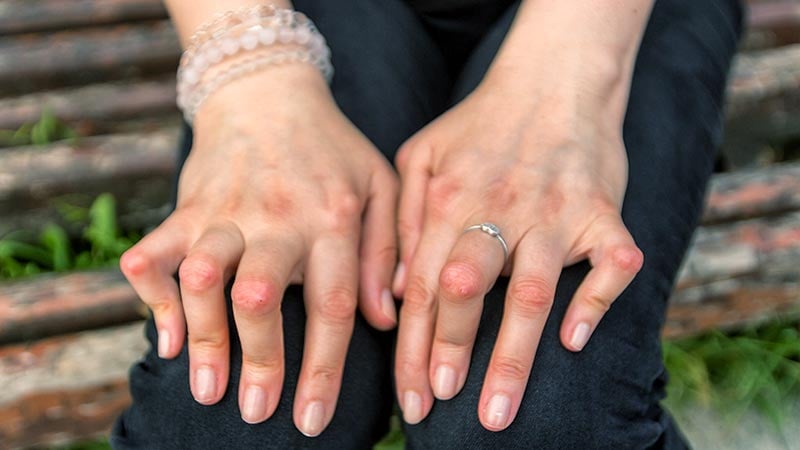Despite the rising incidence of rheumatoid arthritis (RA), extra-articular manifestations have become rare in the era of modern treat-to-target therapy. However, they still present clinical challenges — particularly in the case of rheumatoid nodules. In addition to the need to rule out serious differential diagnoses and address potential complications, especially those involving the lungs, these recurrent inflammatory granulomas can affect daily life not only cosmetically but also functionally.
Christopher Edwards, MD, professor of rheumatology at University Hospital Southampton in Southampton, England, discussed the clinical relevance and management of rheumatoid nodules during the 2025 Annual Meeting of the European Alliance of Associations for Rheumatology.
When Edwards began his career in rheumatology, the presence of rheumatoid nodules was considered a key diagnostic criterion for RA. If not found on the hands, clinicians often examined the elbows and Achilles tendons, which are also common sites. Histologically, rheumatoid nodules are granulomatous inflammatory lesions that evolve through multiple stages. While often subcutaneous, they can also be found on the sclera, larynx, heart valves, and — most significantly — in the lungs.
Biopsy When Malignancy Is Suspected
Pulmonary nodules can present diagnostic difficulties. “I’ve seen patients who were initially told they had lung metastases,” Edwards recalled. Waiting for further imaging and biopsy can be highly distressing for patients. Granulomatosis with polyangiitis can also resemble rheumatoid nodules, further complicating the diagnosis.
It is especially important to distinguish these nodules from infections such as tuberculosis. Patients with RA are at increased risk for infection due to both the underlying disease and immunosuppressive treatment. Like tuberculomas, pulmonary rheumatoid nodules can undergo central necrosis when exposed to tumor necrosis factor-alpha inhibitors, leading to cavitation or even pneumothorax. “Any cavity in the lung can become infected,” Edwards cautioned.
Diagnosing Peripheral Nodules
Diagnosing peripheral rheumatoid nodules is usually straightforward. These nodules typically feel rubbery on palpation and are movable relative to the underlying tissue. Important differential diagnoses include gouty tophi, lipomas, epidermoid cysts, infectious granulomas, sarcoidosis, and neoplastic lesions.
Imaging tools such as ultrasound or fine-needle aspiration can help clarify the diagnosis, particularly when gout is suspected. “Biopsy is rarely required — only if there’s concern about a neoplastic or malignant process,” Edwards explained.
Better Disease Control, Fewer Nodules
“In my practice, I see very few nodules these days,” said Edwards. Epidemiological data support this trend: The 10-year cumulative incidence of subcutaneous nodules in RA patients decreased from 30.9% between 1985 and 1999 to 15.8% between 2000 and 2014.
Multiple factors likely contributed to this decline, including the earlier initiation of more effective therapies and a reduction in smoking rates. Smoking remains a major risk factor for nodule development, along with long-standing, severe RA, male sex, and seropositivity for rheumatoid factor or anti-cyclic citrullinated peptide antibodies. “Patients with nodules are almost always seropositive,” Edwards noted.
These findings suggest that maintaining tight control of disease activity is more critical for preventing nodules than concerns about drug-induced nodulosis.
Little Reason to Discontinue Methotrexate
“There was a time when we worried that methotrexate might be causing nodules,” Edwards said, referring to anecdotal reports of increased nodulosis after initiating methotrexate (MTX). “But now we’re using more MTX and seeing fewer nodules.”
He emphasized that the presence of nodules alone should not prompt discontinuation of MTX. “It wasn’t a reason to stop methotrexate back then, and it’s not a reason now — though in some cases, it may justify a more aggressive treatment approach.”
Other medications — particularly tumor necrosis factor inhibitors like etanercept — have also been linked to nodule development, though Edwards suggested this may reflect reporting bias. “It might not be causal,” he said.
Often, treatment isn’t necessary. “Sometimes it’s just a matter of observation,” Edwards noted. Painful or functionally limiting nodules may be managed with local glucocorticoid injections to reduce discomfort and soften the nodules. However, he admitted he had never personally injected a rheumatoid nodule.
He also cautioned against injections over the elbow. “There’s something about the skin and the olecranon bursa that makes infections more likely in that area. I saw one patient who needed plastic surgery after an infection left a significant wound.”
Rheumatoid nodules also have a tendency to recur.
When to Consider Surgery
“Surgery can benefit some patients,” Edwards said. Surgical removal may be warranted for nodules that ulcerate, become infected, or impair function — such as large nodules on the thumb or fingertip that interfere with gripping. “Patients are usually happy to regain function, even if the nodule comes back a couple of years later.” Nodules that are consistently irritated by shoes or clothing straps may also merit removal.
Pulmonary rheumatoid nodules — unlike subcutaneous ones — often contain B cells and typically respond well to rituximab or abatacept. “These lung nodules tend to shrink or stabilize with rituximab, and certainly, no new ones seem to develop,” Edwards noted. Case reports and small series have also documented improvement with Janus kinase inhibitors.
This story was translated from Medscape’s German edition.
